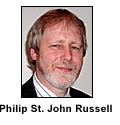HAMBURG, Germany, Sept. 7 -- The 2005 Korber European Science Award has been presented to Philip St. John Russell, professor of physics at the University of Bath in England, for his work developing a new type of optical fiber known as a "photonic crystal fiber" that can be used in data transfer, laser, sensor and biomedical and medical technology applications.
 A Korber Foundation panel chaired by Max Planck Institute President Peter Gruss selected Russell, who heads the photonics and photonic materials working group at the University of Bath, as the recipient of this year's 750,000 euro Korber Prize.
A Korber Foundation panel chaired by Max Planck Institute President Peter Gruss selected Russell, who heads the photonics and photonic materials working group at the University of Bath, as the recipient of this year's 750,000 euro Korber Prize.
One of the most common uses of conventional optical fibers today is for internet data transfer. These conventional fibers are hollow macaroni-like tubes through which light pulses are conducted. Invented by Russell in 1991 and since developed into various products, these new photonic crystal fibers consist of a bundle of glass cores or tubes with a thin casing around them. Each fiber is only about 100 µm thick, which is one-fifth the thickness of a human hair.
The distinctive structure of these fibers, which have completely new properties, allows for more effective conduction of light. Russell said he plans to use the prize money to build improved optical and infrared lasers, as well as compact sources of ultraviolet and x-ray light, which could be used in the future to manufacture intricately structured computer chips. Russell's photonic crystal fibers have already led to the building of an extremely accurate optical clock.
Future potential applications of the fibers include the optical analysis of gases that stream through voids, as well as applications that would allow cells to be moved through tubes using light rays, to enable processing of these cells for biological or medical purposes. There are also potential uses for photonic crystal fibers in the fields of biology, industrial manufacturing, biochemistry, astronomy and medicine.
The Korber Prize, presented every year for the past 20 years, was until recently only awarded to research teams whose members worked on projects from a number of European countries. But now the prize is awarded in alternate years to a single scientist for specific research. To strengthen the prize's ties to European research, and to widen the search for European scientists, the Korber Foundation has established two search committees in addition to the existing trustee committee: one for the life sciences and another for the technical sciences.
For more information, visit: www.koerber-stiftung.de